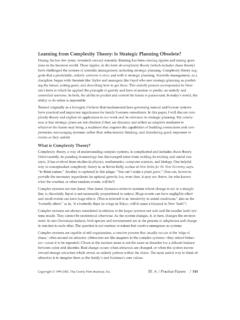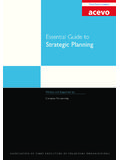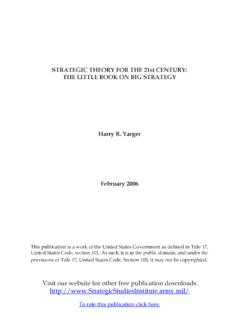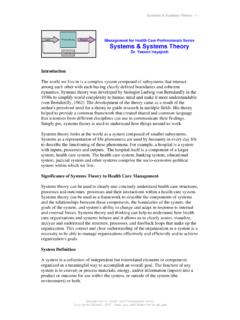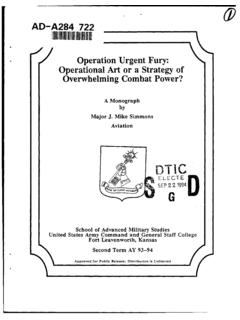Transcription of Grantcraft: Using a Theory of Change
1 Mapping ChangeUsing a Theory of Change to Guide planning and EvaluationContents 2 What is a Theory of Change ? By mapping a process of Change from beginning to end, a Theory of Change establishes a blueprint for the work ahead and anticipates its likely effects. A Theory of Change also reveals what should be evaluated, when, and how. 4 Why would a grant maker develop and use a Theory of Change ? Developing a Theory of Change may sound complicated, but many grant makers have found that the process can help to clarify and simplify people s thinking. This section outlines some practical advantages of developing a Theory of Change within your foundation or with grantees. 6 A mini-case study: Theory of Change as the basis for strategic planning To prepare for a major capacity-building grant, one foundation invited its prospective grantee to draft a Theory of Change .
2 More than just a planning exercise, the process drove the organization s leader-ship team to articulate some basic assumptions about their work. 9 Common questions about Theory of Change In this section, grant makers answer some recurring Theory of Change questions: Is Theory of Change for foundations, or grantees, or both? How do foundations help grantees with the process? How does Theory of Change lend itself to evaluation, or to assessing the impact of a foundation s grant making? grantcraft PRACTICAL WISDOM FOR GRANTMAKERSThis guide was written by Anne Mackinnon and Natasha Amott, with assistance from Craig McGarvey. It is part of the GrantCraft series. Publications and videos in this series are not meant to give instructions or prescribe solutions; rather, they are intended to spark ideas, stimulate discussion, and suggest possibilities.
3 Comments about this guide or other GrantCraft materials may be sent to Jan Jaffe, project leader, at order copies or download .pdf versions of our publications, please visit are welcome to excerpt, copy, or quote from GrantCraft materials, with attribution to GrantCraft and inclusion of the copyright. 2006 Techniques:A Series of Brief Guides Mapping Change : Using a Theory of Change To gU ide planning and eval UaTionWhat is a Theory of Change ?A Theory of Change describes a process of planned social Change , from the assumptions that guide its design to the long-term goals it seeks to achieve. Grant makers who have created theories of Change explain that having a Theory helps them and their grantees draw logical con-nections between activities and outcomes.
4 It helps them to articulate exactly what propositions and assumptions their work is testing and therefore what they should be assessing in their evaluation makers, grantees, and Theory of Change consultants seem to share a common sense of the process for developing a the-ory of Change . The work often starts by gathering together the key planners of an action or program, a group that may involve grant makers, project designers, evaluators, community residents, and other constituents. The Theory unfolds as the planners work backward from the long-term impact they re seeking to achieve through specific goals, strategies, and milestones. At each step, they carefully probe the assumptions that underpin their beliefs about what will work and why and how it is likely to have the effect they does Theory of Change really mean, in practice?
5 Grant makers who use the term may be describing anything from a detailed map to a general storyline. What they agree on is that a Theory of Change is valuable if it helps them and their grant-ees understand the relationship between the problems they re addressing and the strategies they re Using to get the work done. As one former grant maker put it, When you re clear about your Theory , it s easier to see what s possible and what s not possible to achieve with the intervention you ve chosen to support. It helps you think about what other inputs might be needed and whether your input might fit in a catalytic place. And it helps you examine whether or not your intervention will be powerful enough.
6 At the formal end of the Theory -of- Change spectrum, one grant maker worked with a grantee to develop a seven-page flow chart that was used to test ideas for a field-building initiative with colleagues at a large foundation. Starting with assumptions about the environment in which grantees are doing their work, they diagrammed four initiative goals, each supported by a set of assumptions about why and how that particular goal would be important. They then broke each goal down into discrete objec-tives and grant making strategies, along with key evaluation questions and milestones that would indicate progress toward each goal. Interestingly, among the assumptions mapped were the grant maker s own active role in an emerging field.
7 More informally, another grant maker explained the Theory behind a program to improve conditions for low-income children: The basic idea was that children do well when their families do well, and families do well when they re supported in neigh-borhoods, and being a supportive neighborhood means having opportunities for families to connect to economic opportunity, social networks, and quality services and supports.. It was a different way to frame the problem. The problem isn t families; the problem is that families aren t connected. That insight led the foundation s program staff to ask local teams of residents to design interventions to help families connect to systems of sup-port in their own example comes from a grant maker at a foundation that sees its own Theory of Change as a basic set of principles or values about the way we do our work.
8 By articulating those principles and values (mainly having to do with the importance of ensuring that poor people are involved in designing poverty reduction pro-grams), and by doing some prodding and critical analysis to test the commitment of prospective grantees to those same values, the foundation is better able to see if the match is right. Where the examples in this guide come fromThis guide draws on the experiences of grant makers, grantees, and consultants who have used theories of Change to plan, guide, and evaluate their work. Our contributors come from a variety of fields, including education, job training, local economic develop-ment, international human rights, health care, and management.
9 Their experiences with Theory of Change are also widely varied: we talked with long-time users and newcomers, professional evaluators and nonprofit executives, people who have written about Theory of Change and people who aren t quite sure what the term really means. Our goal has been to gather and share knowl-edge about an area of practice that many grant makers say they find both intriguing and confusing. A complete list of those who contributed to this guide is on page 11. Mapping Change : Using a Theory of Change To gU ide planning and eval UaTionTheory of Change or logic model? Some people use the terms Theory of Change and logic model interchangeably. Others say that it is important to maintain a distinction between the two.
10 What do the two terms mean? And what s the difference between them? A Theory of Change takes a wide view of a desired Change , carefully probing the assumptions behind each step in what may be a long and complex process. Articulating a Theory of Change often entails thinking through all the steps along a path toward a desired Change , identifying the preconditions that will enable (and possibly inhibit) each step, listing the activities that will produce those conditions, and explaining why those activities are likely to work. It is often, but not always, pre-sented as a flow chart. A logic model takes a more narrowly practical look at the relationship between inputs and results.

